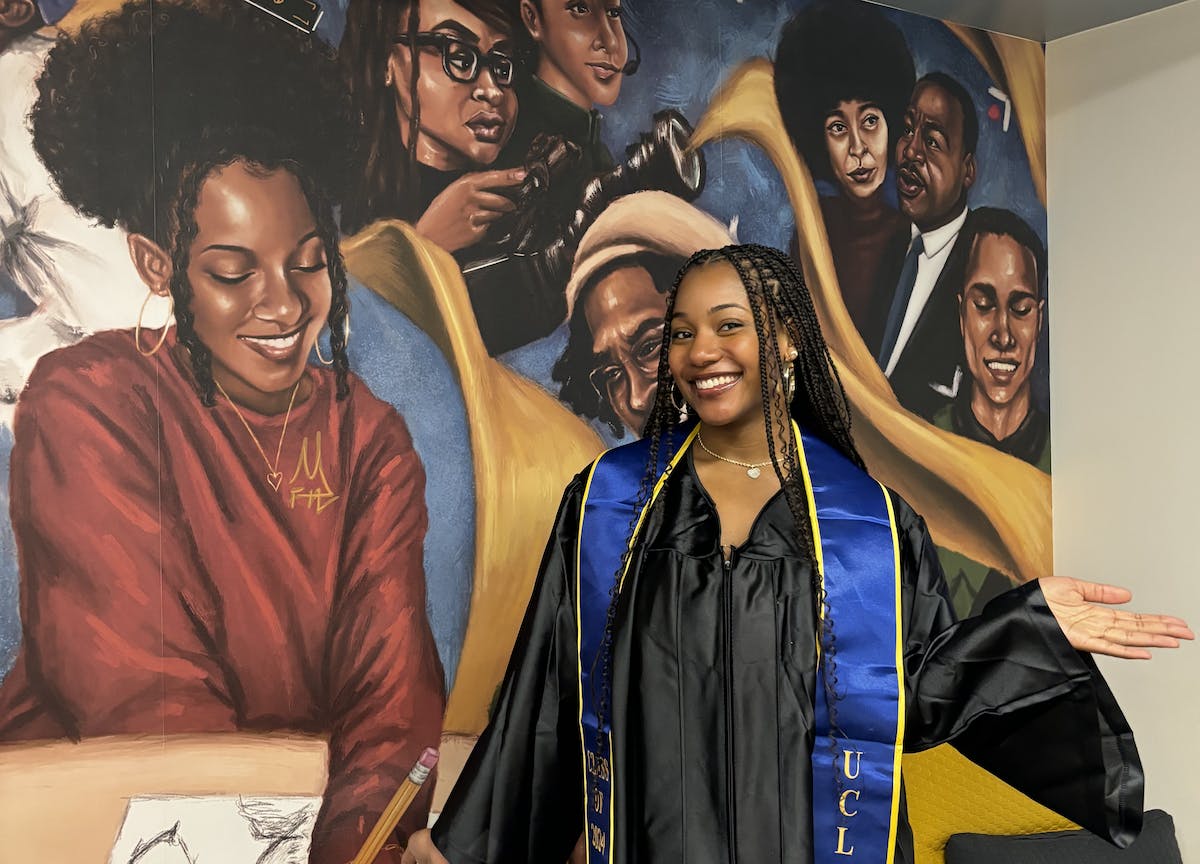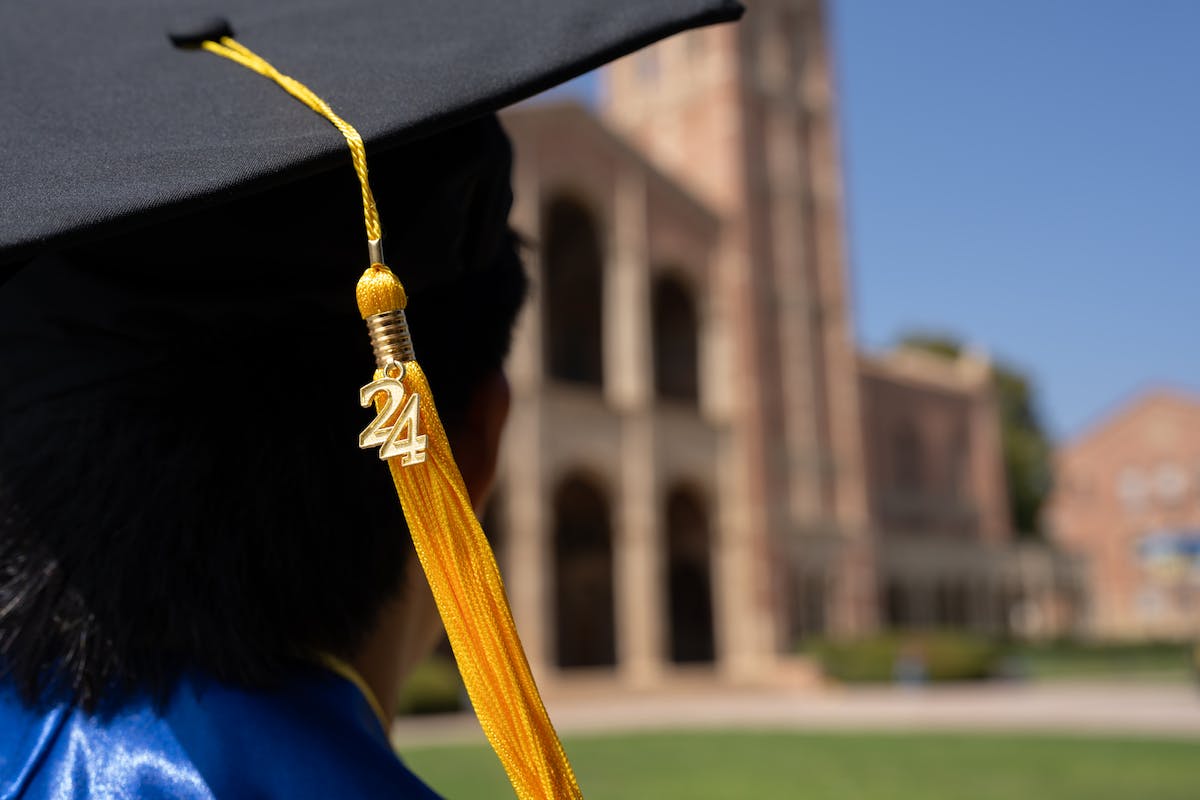Maia Faith Hadaway embraces the emotional journey of artmaking

Maia Faith Hadaway is leaving her mark on UCLA.
Graduating with a major in the department of art and a minor in African American studies, in 2021 Hadaway unveiled “A Seat at the Table,” the 18-by-7-foot mural depicting Black Bruins from past to present that she was commissioned to create for the new Black Bruin Resource Center. A piece of hers was also recently selected to be part of the permanent collection of Associated Students of UCLA as part of its Art in the Union annual competition. And for this year’s Class Artist competition from the Chancellor’s Council on the Arts, Hadaway was acknowledged with an honorable mention.
“Sometimes I find it surreal walking back into the BBRC or seeing them post and my work is in the background,” she said. “And I love seeing people sitting in front of it because it really feels like they're an extension of the mural–my original intent. Someone actually reached out to me recently and thanked me for making the mural because every time she goes in there, she's encouraged to keep working harder so that she can make her own mark in history.”
Hadaway discovered as a young child growing up near Chicago that drawing allowed her to focus and fall into a relaxed mind state, a trait she has also begun to witness in her young son. While she was an academic high achiever in high school, that 4.1 GPA didn’t come easily and standardized tests were a challenge for her as a self-described “long processor.”
“I consider myself a student of life, I love to learn, but it takes me time. I need time,” she said.
Hadaway’s creative practice is rooted in themes of identity, human connection, faith and empathy. She paints layered portraiture through the concept of "recurring characters" throughout her work, allowing the viewer to see individuals in different contexts. Her subject matter is largely influenced by or specifically reflects people she knows and loves.
“There's a way that you paint when you know people,” she said. “When you know who they are and know how they feel, it's like you're not really going off the picture anymore. You're going based off what you feel and what you know.”
Her breakthrough moment came when, during a studio visit, a supportive graduate teaching assistant in her department, Jarvis Boyland, noted that he could tell that some of the figures in a particular work were based on people Hadaway must know due to her ability to reflect their essence in the piece. The two figures were in fact her aunt and uncle.
“And ever since, I've been strictly painting people that I know and I’m really able to take creative liberty with what I'm doing because I'm not focused on all the details,” she said. “Instead I lean in to the essence of each connection.”
One of the favorite works Hadaway created during her time at UCLA is titled “Christmas ‘97.” It's based on a photograph, cherished within the family, of her father holding her sister as a baby—a photo that gained new significance for Hadaway after she became a mother herself.

“All of a sudden I was like, I know exactly what that feeling is, and it came together so quickly,” she said. “I just let myself respond to what I felt without second guessing. As my dad’s daughter, I could take on both roles of the characters in the painting. It could be considered a self-portrait in that way, where I could relate to the baby’s perspective but could, just as easily, see things from my dad's vantage point. It made me realize that everything I create has the potential to become a self-portrait in some way and in doing that, it just adds a whole other layer of emotion ”

One particularly important aspect of being an artist that Hadaway has learned at UCLA and plans to carry with her is to tell her own truth with her work, especially when she finds herself confronting or reflecting external or societal issues that are part of her practice.
Looking ahead, Hadaway hopes to create a career as a professional artist. She has visions of developing multi-sensory exhibitions that take viewers on a narrative journey.
If Hadaway could send a message to her fellow graduates in the class of 2024 she would encourage them to think about all the ways they might view themselves as creative beings and also harness the power of art to channel emotions they might otherwise suppress.
“I think art helps us to feel, and feelings are something that we have been told to put away,” she said. “Even smiling too hard is something that people are reserved about. Some want to laugh but don't because they don’t know if other people are going to laugh with them. Some have the urge to cry, but don't because they don't want to seem weak But art gives you space to feel, and that's why it's important, because we forget to do it.”
Story by Jessica Wolf
All images courtesy Maia Faith Hadaway
Posted 06.10.24

